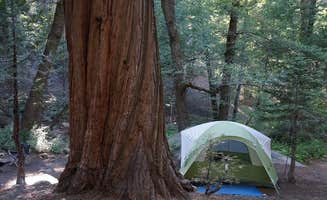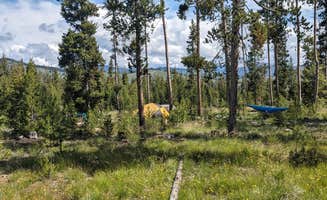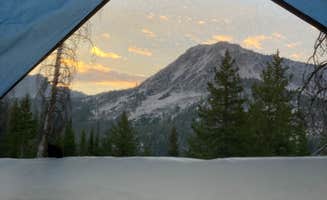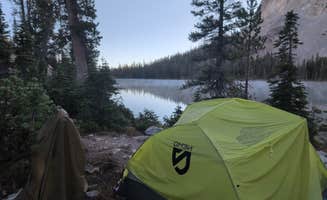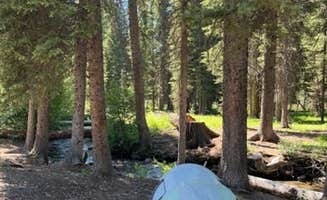Tent camping in the Clayton, Idaho region puts visitors in high elevation terrain near rivers and alpine lakes. Located in the East-Central part of the state at approximately 6,000 feet elevation, Clayton tent sites experience wide temperature variations with cold nights even in summer. Recreational opportunities center around mountain streams, wildlife viewing, and access to surrounding wilderness areas.
What to do
Fishing access points: Several campgrounds provide direct access to fishing opportunities. At Nip and Tuck Rd - Dispersed Camping, campers can fish in nearby streams while enjoying mountain views. One visitor mentioned, "This stretch of dispersed camping is amazing. Above the town of Stanley and overlooking the Sawtooths."
Backcountry hiking routes: The area connects to extensive trail networks. Redfish Inlet Trailhead serves as a gateway to wilderness trails. According to one camper, "This is a great place to set off into the vast Sawtooth wilderness! If you want to set off and get away from clouds or sit near a beautiful lake then this site is perfect!"
Wildlife observation: Early morning and evening hours offer prime wildlife viewing opportunities at quieter campgrounds. A camper at Redfish Inlet noted, "Beautiful campgrounds with fearlessly friendly deer who visit your evening campfire." Sites near water sources typically provide the best wildlife viewing potential.
What campers like
Isolation from crowds: Many campers appreciate the quieter camping options in this region. A visitor to Basin Creek Transfer Camp Trailhead enjoyed the "Creekside delight" with "a few nice options by the creek" away from busier areas.
Accessibility without overuse: The balance of road access without overcrowding appeals to many visitors. At Nip and Tuck Road, a camper reported, "I passed quite a few people but spots are pretty far apart and the only people I could see from my campsite were all the way across the valley."
Water proximity: Creekside and lakeside camping ranks high among visitor preferences. One camper described Challis National Forest Little Bayhorse Campground as a "Great spot in the woods. Near a lake with fishing and hiking opportunities. Campsites are clean with good spacing between them."
What you should know
Road conditions vary significantly: Access to some sites requires careful planning. Regarding Nip and Tuck Road, a reviewer cautioned: "Do not come in from the East on NF-633/Nip and Tuck Road off of Hwy 75 as just a short distance in, there is deep and narrow wash across the road that will likely ruin the underside of your RV."
Water availability concerns: Most tent sites near Clayton require campers to bring their own water. Basin Creek campsites have no potable water sources on site.
Insect activity changes seasonally: Different camping areas experience varying insect pressure. Basin Creek Transfer Camp was described as "Little buggy in early season, this is normal for the region," while at Nip and Tuck Road, a visitor noted "There were a few flies around during the daytime, but not the biting kind, just annoying. Mosquitos were an issue only in the evenings."
Campsite finding timing: Weekday arrivals significantly improve site availability. A visitor to Nip and Tuck Road noted, "Got to Stanley area around 6pm on a Friday. Drove to Stanley Lake and Iron Creek but everything was full. Decided to drive down Rd 653 then to Rd 633 to see if there was anything open and found a good spot about 2 miles in from hwy 21."
Tips for camping with families
Boat-accessible sites: For families seeking unique experiences, Redfish Inlet Trailhead offers boat-in camping. A visitor described it as a "Family friendly peaceful spot" with a "Gorgeous little boat ride from Redfish Lodge."
Shallow water play areas: Look for camping areas with gradual water entry for safer play. While specific beach conditions aren't detailed in reviews, several campgrounds provide creek access with variable water depths.
Seasonal planning matters: The region's short summer season makes timing crucial for family trips. Redfish Lake visitors noted weekdays in May had "hardly anybody there," while "weekends can get pretty crowded."
Tips from RVers
Cell service considerations: Coverage varies significantly between camping areas. At Nip and Tuck Rd, a full-time RVer reported, "AT&T service was fair with 2-3 bars of LTE and speeds up to about 1.5 MB/s. T-Mobile service was good with 3 bars of 4G/LTE and speeds up to about 1.3 MB/s."
Leveling requirements: Expect to need leveling equipment at most sites. A Nip and Tuck Road camper noted their site "sloped a bit from side to side, but we were able to get mostly level."
Size limitations: Many forest service roads restrict larger RV access. For Nip and Tuck Road dispersed camping, a visitor with a larger RV noted, "We are full-timers and have a 36 ft Class A with a Cherokee Trailhawk tow and had scouted the area before arriving with the RV. The roads in to this area, NF-563/Stanley Creek Rd and NF-633/Nip and Tuck Road are in pretty decent shape for all vehicles."


